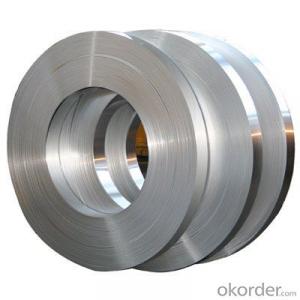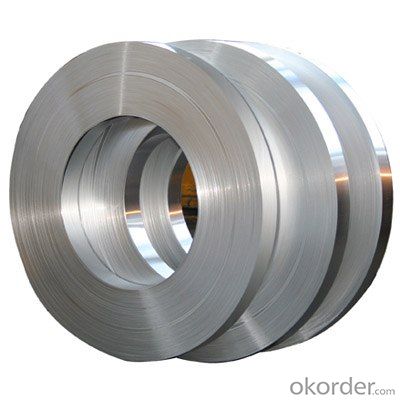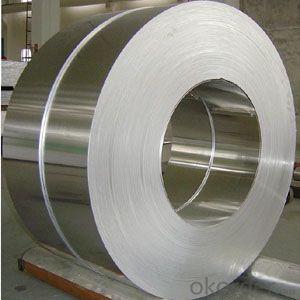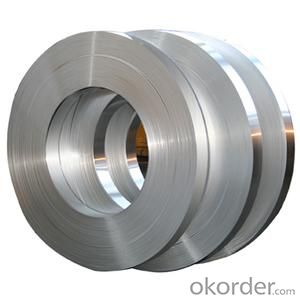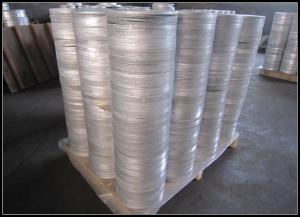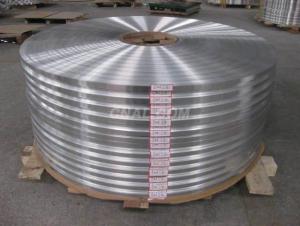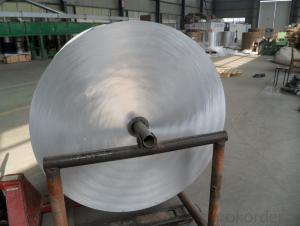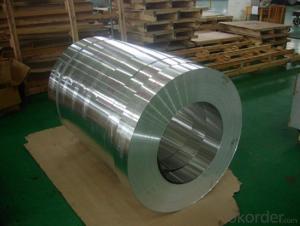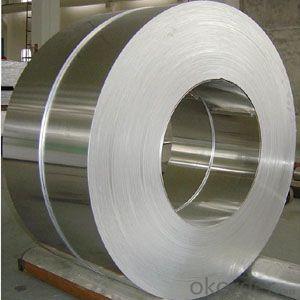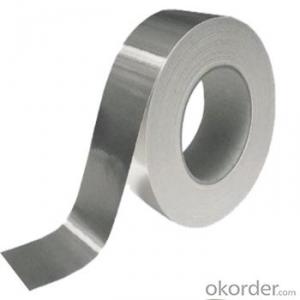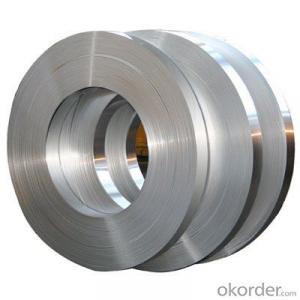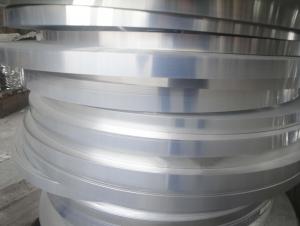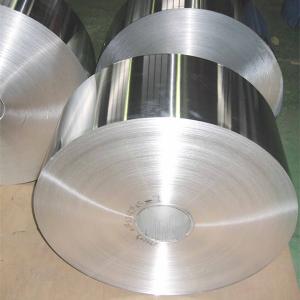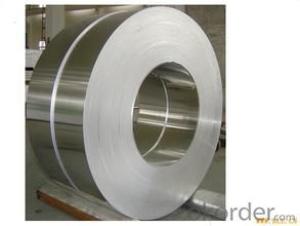Thin Aluminum Strips for Wide Consumer Market
- Loading Port:
- Shanghai
- Payment Terms:
- TT OR LC
- Min Order Qty:
- 5 m.t.
- Supply Capability:
- 5000 m.t./month
OKorder Service Pledge
OKorder Financial Service
You Might Also Like
Aluminium alloys with a wide range of properties are used in engineering structures. Alloy systems are classified by a number system (ANSI) or by names indicating their main alloying constituents (DIN and ISO).
The strength and durability of aluminium alloys vary widely, not only as a result of the components of the specific alloy, but also as a result of heat treatments and manufacturing processes. A lack of knowledge of these aspects has from time to time led to improperly designed structures and gained aluminium a bad reputation.
One important structural limitation of aluminium alloys is their fatigue strength. Unlike steels, aluminium alloys have no well-defined fatigue limit, meaning that fatigue failure eventually occurs, under even very small cyclic loadings. This implies that engineers must assess these loads and design for a fixed life rather than an infinite life.
Aluminium foil acts as a total barrier to light and oxygen (which cause fats to oxidise or become rancid), odours and flavours, moistness, and germs, it is used broadly in food and pharmaceutical packaging. The purpose of aluminium is to make long-life packs (aseptic processing|aseptic packaging) for drinks and dairy goods, which allows storing without refrigeration. Aluminium foil containers and trays are used to bake pies and to pack takeaway meals, ready snacks and long life pet foods.
Aluminium foil is widely sold into the consumer market, often in rolls of 500 mm (20 in) width and several metres in length.It is used for wrapping food in order to preserve it, for example, when storing leftover food in a refrigerator (where it serves the additional purpose of preventing odour exchange), when taking sandwiches on a journey, or when selling some kinds of take-away or fast food. Tex-Mex restaurants in the United States, for example, typically provide take-away burritos wrapped in aluminium foil.
Aluminium foils thicker than 25 μm (1 mil) are impermeable to oxygen and water. Foils thinner than this become slightly permeable due to minute pinholes caused by the production process.
Aluminium foil has a shiny side and a matte side. The shiny side is produced when the aluminium is rolled during the final pass. It is difficult to produce rollers with a gap fine enough to cope with the foil gauge, therefore, for the final pass, two sheets are rolled at the same time, doubling the thickness of the gauge at entry to the rollers. When the sheets are later separated, the inside surface is dull, and the outside surface is shiny. This difference in the finish has led to the perception that favouring a side has an effect when cooking. While many believe that the different properties keep heat out when wrapped with the shiny finish facing out, and keep heat in with the shiny finish facing inwards, the actual difference is imperceptible without instrumentation.The reflectivity of bright aluminium foil is 88% while dull embossed foil is about 80%.
We provide a full range of precision aluminum strip for almost any application. We produce aluminum strip in a wide variety of alloys, including clad composites. Our aluminum strip can be produced in standard dimensions or custom made to your special requirements. We produce both imperial and metric units. We manufacture in compliance with the main international specifications, and tighter tolerances or custom tempers are available upon request. We offer various surface conditions, custom finishes (painting, anodizing, embossing), special processing, and multiple packaging options to meet our customer's unique requirements. The following is a summary of our capabilities.
Manufactured in compliance with the main international specifications and standards, including: Aluminum Association, ASTM, EN, and DIN.
We can also manufacture in compliance with other international standards including:ASME, SAE, AMS, AWS, FED, MIL, QQ, ISO, BS, AFNOR, JIS and GOST.
Manufactured in compliance with the main international specifications and standards.
Tighter tolerances are available upon request.
- Q: This question asks for a list of various types of aluminum components used in the automotive industry.
- <p>Aluminum is widely used in the automotive industry due to its lightweight and high strength. Different types of automotive aluminum parts include engine components such as cylinder heads and blocks, transmission housings, suspension parts like control arms and knuckles, wheels and rims, body panels, and doors. Other applications include heat exchangers, radiators, and various brackets and structural components. The use of aluminum can significantly reduce the weight of vehicles, improving fuel efficiency and performance.</p>
- Q: Explain the differences between aluminum strips and aluminum foil.
- <p>Aluminum strips and aluminum foil, while both made of aluminum, differ in their form and usage. Aluminum strips are typically long, narrow pieces of aluminum, often used for structural purposes or as a component in various applications due to their strength and flexibility. They can be found in various thicknesses and widths, suitable for industrial and construction uses. Aluminum foil, on the other hand, is a thin, pliable sheet of aluminum, commonly used in cooking, food packaging, and insulation. It is much thinner than aluminum strips and is known for its high malleability and heat resistance, making it ideal for wrapping food and baking.</p>
- Q: What distinguishes extruded aluminum strips from rolled ones in terms of manufacturing process and properties?
- <p>Extruded aluminum strips are formed by forcing aluminum through a die, creating a specific profile or shape. This process results in a more uniform cross-section and can produce complex profiles. Extruded strips are stronger and have better dimensional stability due to the grain flow being aligned with the direction of the extrusion. Rolled aluminum strips, on the other hand, are created by passing aluminum between rollers to achieve the desired thickness and width. This method is more suitable for producing thin, wide strips and is less costly for simpler profiles. Rolled strips may have some residual stresses and are not as strong as extruded ones, but they are more flexible and can be used in applications requiring formability.</p>
- Q: What are the benefits of utilizing tailor-made aluminum strips?
- <p>Custom-made aluminum strips offer several advantages, including precise fit and dimensions tailored to specific applications, enhanced durability due to the material's strength and corrosion resistance, and cost-effectiveness as they can be designed to minimize waste. They also allow for unique designs and shapes that standard strips may not offer, providing a competitive edge in industries where aesthetics and functionality are crucial. Additionally, custom aluminum strips can be anodized or coated to meet specific color or finish requirements, enhancing their versatility in various applications.</p>
- Q: Is it possible to use aluminum strips for decking purposes or for a neighbor's house?
- <p>Yes, you can use aluminum strips for your deck or your neighbor's house, provided it is for decorative or structural purposes approved by local building codes. Aluminum is known for its durability, resistance to corrosion, and low maintenance requirements, making it a popular choice for outdoor applications like decks. However, it's important to check with local regulations and consult with a professional to ensure the proper installation and use of aluminum strips to avoid any safety or legal issues.</p>
- Q: This question seeks to understand the distinctions between two common metal materials: aluminum strips and steel sheets.
- <p>Aluminum strips and steel sheets differ in material composition, properties, and applications. Aluminum strips are made from aluminum, a lightweight metal known for its corrosion resistance and high thermal conductivity. They are often used in applications requiring light weight and flexibility, such as in electrical wiring or heat exchangers. Steel sheets, on the other hand, are made from steel, which is an alloy of iron and carbon. Steel is stronger and more durable than aluminum, making it suitable for construction, automotive, and heavy machinery. Steel also has higher magnetic permeability and is more resistant to wear. The choice between aluminum strips and steel sheets depends on the specific requirements of the project, such as strength, weight, and environmental conditions.</p>
- Q: This question asks for a comparison of the benefits and drawbacks of using aluminum strips.
- <p>Aluminum strips offer several advantages, including high strength-to-weight ratio, making them lightweight yet durable. They are also corrosion-resistant, which is beneficial in various environments. Aluminum is a good conductor of heat and electricity, which is useful in applications requiring thermal or electrical conductivity. Additionally, aluminum is cost-effective and widely available. Disadvantages include its lower strength compared to some other metals, making it less suitable for heavy-duty applications. It can also be prone to denting and is not as easily repaired as some materials. Lastly, while it's recyclable, the recycling process can be energy-intensive.</p>
- Q: Can aluminum strips be utilized as materials for car body panels?
- <p>Yes, aluminum strips can be used for car body panels. Aluminum is known for its lightweight, high strength, and corrosion resistance, making it an ideal material for automotive applications. It offers better fuel efficiency due to reduced weight and improved safety due to its strength. Additionally, aluminum's recyclability makes it an environmentally friendly choice. However, it's important to note that aluminum requires different manufacturing techniques compared to traditional steel, and it may be more expensive.</p>
- Q: Is it possible to use aluminum foil as a material for roofing purposes?
- <p>While aluminum foil itself is not a suitable roofing material due to its lack of durability and structural strength, it can be used as a temporary solution in emergency situations or for small repairs. Aluminum foil is not designed to withstand the elements over time, nor does it provide the necessary insulation or protection against water and wind that a proper roofing material should. For long-term roofing solutions, it's best to use materials specifically designed for roofing, such as asphalt shingles, metal sheets, or tiles, which offer greater durability and weather resistance.</p>
- Q: The user is asking if it's possible to use aluminum strips in the construction of solar panels.
- <p>While aluminum is a common material used in the construction of solar panels, particularly for framing and mounting, it is not used to create the actual solar cells. Solar cells are typically made from silicon, which is capable of converting sunlight into electricity. Aluminum strips can be used in the assembly and support structure of solar panels, but they do not contribute to the photovoltaic effect that generates electricity. Therefore, you cannot use aluminum strips to make the active solar cell component of solar panels.</p>
Send your message to us
Thin Aluminum Strips for Wide Consumer Market
- Loading Port:
- Shanghai
- Payment Terms:
- TT OR LC
- Min Order Qty:
- 5 m.t.
- Supply Capability:
- 5000 m.t./month
OKorder Service Pledge
OKorder Financial Service
Similar products
Hot products
Hot Searches
Related keywords
